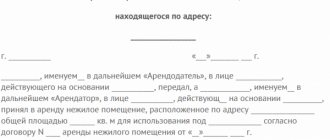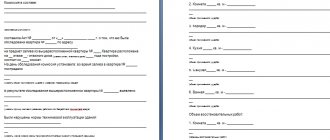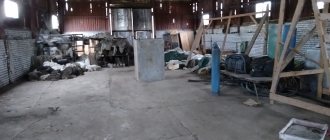Free legal consultation by phone:
8
Owners of residential and non-residential properties are responsible for their condition. In some cases, violations during the operation of premises may result in losses for the owners of adjacent properties. In particular, such situations relate to flooding of non-residential premises.
A large number of commercial properties are located on the ground floors of apartment buildings. Accordingly, owners of apartments located higher up often flood these objects. Such situations cause serious disputes and conflicts. Often, they have to be resolved in court.
Why is it needed?
In the event that the room itself (its ceiling, walls, floor) or the property located in it was damaged as a result of water leakage from the top floor or from an adjacent room, a flood report is drawn up. The document is required for the following purposes:
- It records the damage caused during the flood and is evidence.
- On its basis, in a pre-trial settlement, you can receive compensation from the culprit.
- If it is not possible to resolve the matter amicably, the act becomes the basis of a claim filed in court.
- If there is an agreement on damage insurance, then only with the help of the act can you achieve payments.
- If the premises are used by a legal entity paying taxes, then the act will become one of the grounds for accounting to take into account the costs incurred for restoration (for example, as accelerated depreciation of equipment) - and reflect them in accordance with the Tax Code of the Russian Federation when calculating income tax.
Important! According to Art. 1064 of the Civil Code of the Russian Federation, the causer of damage (no matter whether he acted consciously or did not take care of his property) must compensate everything in full.
Fixing damage
After the flooding has been stopped, the damage must be carefully recorded:
- Measure and indicate the area of damage on the walls, floor, and ceiling.
- Carefully describe the damaged furniture.
- Enter the models of the affected household appliances.
- Make an inventory of the damaged goods.
- Take photos/videos of what happened.
- Indicate what kind of water - hot or cold - flooded the room.
All these details are included in the act and certified by the commission.
Who is present when the document is created?
In addition to the representative of the person using the premises, when drawing up the act there are:
- Representative of the company that owns the building.
- Representative of the owner or user of the premises from which the leak occurred. If one is not found, the act is drawn up without his participation, but the absence of the culprit is noted in the document.
- Witnesses. The law does not say anything about them - but in practice it is extremely desirable that when drawing up the act there were at least two people who do not have their own interest in this matter (employees of companies occupying neighboring premises, casual visitors, etc.).
If the company does not want to compile it
Often it is the management company that is to blame for the flooding and refuses to draw up a report. In this case, the act is drawn up independently (in the presence of witnesses) and sent to the organization by mail (with notification of receipt).
In this case, a note is made in the act that the organization was informed of the need to be present at the accident site, but did not send its representatives to conduct the examination.
How to calculate the damage in this case?
If the management company refused to attend the scene of the accident, did not inspect the damaged non-residential premises, or violates the deadlines for drawing up the report, then an independent appraiser can be invited. This can be a representative of a company or an individual (but must be a member of a self-regulatory organization of appraisers and have insurance).
The expert works with the accident report in hand and verifying ownership. It is not advisable to carry out restoration work until the damage has been assessed.
After completing the inspection and examination, the appraiser draws up a conclusion indicating the amount of damage. Payments for the services of an independent appraiser can be included in the amount of the claim (if one is created).
Why should you choose an independent appraiser?
The damage assessment carried out by the management company often does not provide a complete picture: the culprits of the accident are not identified, but only the facts are recorded. An independent examination can indicate why it happened later and who is to blame.
If a thorough and attentive approach to the matter is required, excluding the interest of any of the parties, it is better to turn to outside specialists. Advantages of an independent examination:
- Technical specialists of the management company inspecting the accident site may be incompetent in some matters.
- If the management organization is to blame for the accident, it is an interested party.
- The consequences of flooding may become apparent after the initial inspection.
- An independent examination guarantees a thorough study of the problem and the appointment of those responsible after a thorough study of the case.
Owners of non-residential premises in apartment buildings may face not only the problem of flooding. We invite you to familiarize yourself with other useful publications devoted to the proper operation of such real estate, its maintenance and payment of utilities:
- The nuances of maintenance and what does operational management of such property mean?
- Peculiarities of major repairs and who should pay for the one-room payment in an apartment building?
- How to properly organize heating: temperature requirements and tariffs, as well as the nuances of paying for electricity.
- How to draw up an employment contract with a cleaner?
- How to connect the Internet in such a room?
General content
The law does not say anything regarding how the act is drawn up and what exactly should be indicated in it. However, in practice, a number of content requirements have been developed for its preparation. According to them, the act states:
- Title of the act.
- Place and time of compilation.
- Composition of persons participating in the execution of the act.
- Cause of flooding. If it was not identified during the inspection, then a note is made in the report that an expert commission is convening to determine the causes of the leak.
- Damage found during inspection.
- Signatures of the parties involved in drawing up the document.
This is just a sample structure. If necessary, the act may contain additional clauses concerning both the persons who took part in the inspection, the conditions of the inspection, or the procedure for assessing damage caused to the property of the injured party.
Determining the culprit
If the leak occurred due to improper actions or breakdowns in the room above, then the culprit is its rightful owner. If the building is completely non-residential, but it has an owner, then he will be the culprit.
If a retail or other space is leased from the state, then the culprit should be determined after a technical inspection of the entire building, recording damage and conducting an examination.
Important! If the culprit of the flood cannot be determined, a note about this is made in the act.
Causes of the accident
The reasons given in the report depend on what exactly happened. For example, the reasons for flooding of non-residential premises may be:
- Careless handling of elements of the water supply system, heating system, etc. located in the room above.
- Structural defect of the tap, battery, etc.
- Destruction of public infrastructure, for which the user of the premises where the flood began is not responsible.
Note! Regardless of what is stated in the report, the culprit can dispute the reason. Therefore, the main thing is to focus on describing the damage.
In any case, accurately determining the causes of flooding will require the involvement of a specialist who understands the communications system.
Damage calculation
The total cost of damage consists of moral damage and deterioration of the physical condition of the items. As a rule, appraisers determine material damage. In fact, the funds that will have to be spent on restoring property are equal to the amount of material damage. Here you can also use two options:
- Repair . In this case, the damage is equal to the cost of the repair, of course, if it returns the equipment and other property to its former functionality.
- Complete replacement . Although the victim will have to buy new property, the original market value will be taken into account, taking into account depreciation. Although wear and tear will not be taken into account if the equipment is new.
Naturally, ordinary housing office employees are unlikely to be able to accurately determine the amount of damage. Therefore, in the case of expensive equipment and repairs, it is better to turn to independent experts.
Moral damage
The law allows any applicant to demand compensation for moral damages from the culprit. This is explained by the fact that flooding causes a certain discomfort and anxiety. The victim must contact the management company to draw up a report and file a claim in court. It is quite logical that for such inconveniences he has the right to receive some compensation.
However, to do this, the court must prove that he subsequently caused significant trouble. For example, the owner of a flooded apartment was pregnant, or the flooding occurred during a period of illness. Excellent evidence would be a medical report, for example, that the injured party’s psychological state has significantly deteriorated. Although absolutely all victims can count on compensation. Here everything will depend on the skills of the lawyer.
How to assess moral damage
As a rule, the amount of moral damage is determined by the amount that was spent on calming the nerves. Often, when a person learns about flooding, his health may deteriorate. For example, money spent on treating a nervous breakdown will be considered moral damages. There are situations when the owner of a damaged apartment has a heart ache. Due to increased humidity, colds or more serious lung diseases may appear. But in court it will be necessary to prove that all this happened precisely because of the flooding. Of course, you can receive moral damage, but you should not count on large sums. Often the treatment itself costs more than the compensation awarded by the court.
Sources
- https://svoe.guru/nezhilaya-sobstvennost/nezhiloe-pomeshhenie/akt-zatopleniya.html
- https://urexpert.online/nedvizhimost/nezhilaya/pravila-polzovaniya/zatoplenie-i-protechka.html
- https://urist.expert/kvartira/zatoplenie/nezhilogo-pomeshheniya.html
- https://pravosudie.guru/nedvizhimost/nezhilaya/pravila-polzovaniya/zatoplenie-i-protechka.html
- https://aktinfo.com/akt-o-zatoplenii-kvartiry/
Types of filling
The official form for the flooding report has not been approved at the legislative level. Therefore, you can fill it out in the following ways:
- If the company servicing the building has pre-prepared forms, fill out the form.
- Handwritten on a regular piece of paper.
- In electronic form, followed by printing and signatures of the persons participating in the inspection of the premises.
All options are equivalent, provided that the act contains all the necessary information. The act itself should usually be drawn up within no more than 12 hours from the moment the user of the premises discovered flooding and contacted the service company or emergency service.
If during the inspection photo or video recording of damage was carried out, a record of this should be made in the report. themselves are attached to the act and can be certified by the signature of witnesses.
Claim
For a peaceful settlement, the victim draws up a document where he indicates what his rights were violated, what he proposes to do to resolve the situation.
Attention! A claim for flooding of non-residential premises is made if there is a need and desire to resolve the problem pre-trial.
In what case is it issued?
After signing the flood report and assessing the damage caused, the person responsible for the accident must compensate for all losses from the irretrievable loss of property, expenses for property restoration and repairs of the premises, as well as other losses, for example, caused by the entrepreneur not receiving a profit as a result of forced downtime.
If the guilty party avoids settlement, then the first step should be an attempt to peacefully resolve the conflict by filing a claim.
Where to send?
The claim is submitted to the culprit by registered mail (the documents sent must be described). The claim can be submitted to the company in person. The document records the incoming number, date, surname and name of the employee who accepted the paper. The submitter also signs the document.
The claim is drawn up in two copies (one for the victim, the other for the culprit). If you can’t bring the papers yourself, you can send them by mail. But be sure to send it by registered mail with acknowledgment of receipt.
How to compose?
Claims must be made only in writing. It can be drawn up either by a lawyer or by the victim himself according to the sample. The document states:
- Full name and other details of the guilty party (address, details, etc.).
- Full name and other data of the injured party (address, details, etc.).
- Place, time of flooding. Inventory of the damaged property (based on the act).
- Description of the victim's expenses.
- Claim for damages.
- Information about the date of flooding, about the property that was damaged at the time of flooding.
- Information about the expenses incurred by the owner in connection with the accident.
- Request for reimbursement of funds spent.
- How does the victim plan to receive funds? For example, “I ask you to compensate for material damage in the amount of /specify/ by transferring to my bank account using the following details /specify/.”
In case of failure to comply with the requirements, the victim reserves the right to go to court within 20 days from the receipt of the claim by the perpetrator.
If the culprit does not accept the claim or does not want to pay the amount in full, then it is necessary to file a claim in court. The victim (owner of the premises) draws up this statement based on the Code of Civil Procedure of the Russian Federation, Art. 131 and 132. The claim must contain a description of the case, the amount of damage, and demands against the perpetrator.
Act on damage to property when performing any work
When unintentional damage to property occurs due to some life situations, for example, work, the resulting damage must be compensated somehow. If we are talking about the property of an enterprise, then damaged items must be written off or repaired. The person responsible for damage may be subject to administrative or financial liability. The basis for these procedures is a regulatory document - an act on damaged property.
At an enterprise, such an act can be drawn up by an authorized financially responsible employee. The commission must include at least 3 employees of the organization.
ATTENTION! If technically complex equipment is damaged, then a competent specialist should be included in the commission or an expert should be invited
How to draw up an act
There is no unified form of the act, but it provides for some points that are mandatory to establish the fact of damage to property. As with any official document, the act must include:
- name of the organization (or use letterhead);
- act number;
- Date of preparation;
- signatures of the commission members and the person who drew up the act.
The main part of the act, which determines its “specialization,” consists of the following points.
- Description of damage:
- what is the damage caused to the property;
- what material assets were damaged (name, inventory number, quantity);
- the approximate amount of damage.
- Information about the culprit of the damage. If it cannot be clearly established, this should be noted in the report. The person responsible must be indicated:
- his name, position;
- the reasons why the damage was caused or allowed to occur;
- information about witnesses (if any).
- Consequences of damage: it is clarified whether the damaged property can be repaired or needs to be written off.
- Applications. They may be additional sources confirming the harm caused, for example, recordings from surveillance cameras, etc.
BytRemontService LLC, Yekaterinburg 08/22/2017
ACT No. 5 On damage to property
In this document, I, the head of the sales department, Anatoly Ivanovich Levanevsky, established that on August 22, 2017, an employee of the administrative and economic department, Antonina Petrovna Revakova, during routine cleaning, unintentionally damaged property belonging to BytRemontServis LLC: LG 34UC79G-B LCD monitor ( pushed off the table onto the floor).
The incident was witnessed by the manager of the sales department, Roman Konstantinovich Sokolenko.
Cause of damage: carelessness when wiping off dust. The monitor needs repair - replacement of the display matrix, with an estimated cost of 1200 rubles
The monitor needs repair - replacement of the display matrix, at an estimated cost of 1200 rubles.
Head of Sales Department /Levanevsky/ A.I. Levanevsky Sales Department Manager /Sokolenko/ R.K. Sokolenko
An employee of the administrative and economic service /Revakova/ A.P. was familiarized with the act. Revakova
Act on damage to property during delivery or transportation of goods
Even if delivery is carried out with all due care, damage to the goods transported cannot be ruled out. Without delving into the reasons and the search for the culprits, it should be noted that the cost of damaged or damaged cargo must be compensated - through insurance, the financial liability of the guilty party, or in another way. The damaged goods themselves must be included in losses when summing up the balance sheet. To do this, you need a documentary basis - an act of damage to property during cargo transportation.
If such problems are discovered upon receipt of the goods, the buyer (recipient), together with the person who delivered the goods (forwarder, courier, driver, company representative), must find out important details that will be mentioned in the act:
- name of the damaged product
- the amount of spoiled cargo in standard units of measurement (pieces, kg, meters, etc.);
- the nature of external damage to the packaging;
- whether the goods were properly packaged, whether there is the necessary marking on the packaging.
IMPORTANT! The act must be drawn up immediately after delivery, in the presence of the party who delivered it. In addition to these details, the act should indicate:
In addition to these details, the act should indicate:
- place of delivery and destination of the cargo;
- data about all parties: sender, carrier, recipient;
- delivery time (according to plan and actual);
- description of goods (in accordance with the documentation);
- what the cargo looked like upon arrival;
- approximate amount of damage.
The findings should establish the cause of the damage and the person responsible for it (if possible).
To ensure reliability, at least two more people must be invited as members of the commission. They can be qualified workers who can assess the damage and certify the damage, for example, an accountant of the recipient organization, a lawyer, a supply manager, etc.
It is advisable to attach additional documentary evidence: photos of the cargo, video recording from the carrier’s car, written evidence from eyewitnesses, etc.
You need to make at least 3 copies of the act:
- for the supplier of goods;
- for the person or company who carried out the transportation;
- for the recipient of the goods.
ACT No. 12 On damage to delivered cargo
Penza, August 17, 2017
The receiver of the goods, representative of Leto LLC Zarubin V.V., drew up this report on the damage to the delivered goods upon receipt.
- Sender of the goods: LLC "Our Lemonade".
- Recipient of the goods: Leto LLC.
- Transportation of goods was carried out by the carrier company Magistral LLC.
- Product description: 30 plastic boxes of Bell lemonade in glass bottles with a capacity of 0.33 l, 12 bottles per box.
- Value of the goods according to documents: 21,510 rubles.
- Consignment note No. 000045278 dated 08/17/2017
- Cargo departure point: Penza, st. Belyakova, 19, warehouse 1.
- Cargo destination: Penza, st. Austrian, 68, warehouse 2.
- Transportation time: estimated - from 12:00 to 14:00 (2 hours), in fact - from 12:30 to 13:45 (1 hour 15 minutes).
- Description of cargo received: upon delivery, 30 plastic boxes of lemonade were received, 12 bottles each, including 2 damaged boxes and 18 broken bottles.
- The packaging has not been opened, the seals are intact.
Applications:
- photographs of damaged boxes;
- photographs of broken bottles.
The established cause of cargo damage: excessive speed during delivery, which led to an accident - violation of transportation standards.
The recipient of the cargo, Leto LLC, is required to reimburse the amount of 2,000 rubles.
Members of the commission Head of the reception point of Leto LLC /Zarubin/ V.V. Zarubin Chief accountant of Leto LLC /Nezlobina/ E.P. Nezlobina Head of Warehouse No. 1 Leto LLC /Petukhov/ G.K. Petukhov
The driver of Magistral LLC /Rukavichkin/ R.A. has been familiarized with the act. Rukavichkin
Department of Rosreestr for the Moscow region
Certificate of book value of property: sample and rules for compilation
Do you want to regularly receive information about land plots in the Moscow region? A special cadastral map of Rosreestr can help with this. It allows you to search for real estate, quickly find out the address, cadastral number of the required object, cost, area, date of registration of the object in the cadastral register, information about the owner and form of ownership, as well as the status of the land plot.
All of the above information is quite important when purchasing, renting, or selling land and real estate in the Moscow region (Moscow region). In addition, you have the opportunity to order a cadastral certificate about the cost, extract, territory plan, as well as a cadastral passport (plot, apartment, premises).
2017 acceptance of applications to the appeal commission for consideration of applications to appeal decisions to suspend the implementation of state cadastral registration or decisions to suspend the implementation of state cadastral registration and state registration of rights under the Administration (Appeal Commission under the Administration) is carried out at a new address: 143002, Moscow region, Odintsovo, st.
We invite you to familiarize yourself with a sample referral for a medical examination from an organization
Stroiteley, 18aHead: Paramedic Alexander NikolaevichTelephone;; Pushchino; Reception schedule: Pre-registration telephone number: –;. Pushchino; Department for Serpukhov Address: 142200, Serpukhov, st. Sovetskaya, d.
Office of Rosreestr for the Moscow Region on the topic: “The need to determine the boundaries (surveying) of land plots” Moscow Region, October 26 – 02.11.2017 from 10:00 to 12:00 there will be a “hotline” of the Office of Rosreestr for the Moscow Region on issues of the determination procedure boundaries (surveying) of land plots.
Questions can be asked by phone. 10/26/2017 In September, the number of accounting actions increased significantly in the Moscow region. Moscow region, October 26 – The Office of Rosreestr for the Moscow Region (Office) summed up the results of work in the established areas of activity for September 2021.
- Lukhovitsky
- Federal State Service registration, cadastre and cartography Rosreestr
- Territorial department of Rosreestr No. 26
Compiled by whom?
On the part of the owner or tenant of the premises, the following persons have the right to participate in the preparation of the act:
- Owner of the premises - if it belongs to an individual.
- Manager (if the non-residential premises are owned or leased by the organization).
- A representative of an organization, authorized by a power of attorney - or, as a last resort, acting on its behalf at his own peril and risk (Article 980 of the Civil Code of the Russian Federation).
Article 980 of the Civil Code of the Russian Federation. Conditions for acting in someone else's interest
- Actions without an order, other indication or previously promised consent of the interested person in order to prevent harm to his person or property, fulfill his obligation or in his other non-illegal interests (actions in the interest of others) must be carried out based on the obvious benefit or benefit and the actual or probable intentions of the interested party persons and with the care and prudence necessary under the circumstances of the case.
- The rules provided for in this chapter do not apply to actions in the interests of other persons committed by state and municipal bodies for which such actions are one of the goals of their activities.









